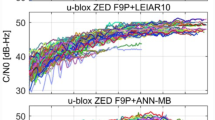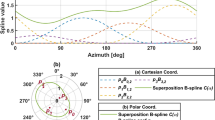Abstract
The features of using survey GNSS receivers for real-time ionosphere monitoring based on high orbital ionosphere tomography network are presented. The related problems and solutions methods are described. The algorithms for calculating total electron content and scintillation indices, that allow reducing errors and noise, are proposed. Special attention is given to the methods reducing data loss during processing. A model of the electron content peak height used for map** ionospheric parameters is also introduced.

Similar content being viewed by others
REFERENCES
I. M. Aleshin, V. V. Alpatov, A. E. Vasil’ev, S. S. Burguchev, K. I. Kholodkov, P. A. Budnikov, D. A. Molodtsov, V. N. Koryagin, and F. V. Perederin, “Online Service for Monitoring the Ionosphere Based on Data from the Global Navigation Satellite System,” Geomagnetizm i Aeronomiya, No. 4, 54 (2014) [Geomagm. Aeron., No. 4, 54 (2014)].
V. V. Alpatov, P. A. Budnikov, A. E. Vasil’ev, V. I. Denisova, V. E. Kunitsyn, V. B. Lapshin, D. A. Molodtsov, S. V. Tasenko, and A. Yu. Repin, “Roshydromet Tomography Network: Establishment Principles, Operation Results, and Prospects,” in Proceedings of the 24th All-Russian Scientific Conference “Radio Wave Propagation,” Vol. 1 (Irkutsk, 2014) [in Russian].
P. A. Budnikov and V. V. Alpatov, “The System for Monitoring Phase and Amplitude Scintillation Indices, TEC Variability Level, and TEC Values in the Russian Federation Based on the GNSS Signal Reception Data,” in Proceedings of the 17th All-Russian Open Conference “Modern Problems of Remote Sensing from Space” (IKI RAN, Moscow, 2019) [in Russian].
E. Aa, W. Huang, S. Yu, S. Liu, L. Shi, J. Gong, Y. Chen, and H. Shen, “A Regional Ionospheric TEC Map** Technique over China and Adjacent Areas on the Basis of Data Assimilation,” J. Geophys. Res. Space Phys., 120 (2015).
V. Alpatov, P. Budnikov, and A. Vasiliev, “Russian Ionosphere Monitoring System Based on GNSS Data,” in 45th Annual European Meeting on Atmospheric Studies by Optical Methods, 2018.
C. J. Benton and C. N. Mitchell, “Further Observations of GPS Satellite Oscillator Anomalies Mimicking Ionospheric Phase Scintillation,” GPS Solution, No. 3, 18 (2014).
L. Dyrud, A. Jovancevic, A. Brown, D. Wilson, and S. Ganguly, “Ionospheric Measurement with GPS: Receiver Techniques and Methods,” Radio Sci., 43 (2008).
R. Ghoddousi-Fard, P. Heroux, D. Danskin, and D. Boteler, “Develo** a GPS TEC Map** Service over Canada,” Space Weather, 9 (2011).
R. Ghoddousi-Fard, P. Prikryl, and F. Lahaye, “GPS Phase Difference Variation Statistics: A Comparison between Phase Scintillation Index and Proxy Indices,” Adv. Space Res., No. 8, 52 (2013).
C. M. Ho, A. J. Mannucci, L. Sparks, X. Pi, U. J. Lindqwister, B. D. Wilson, B. A. Iijima, and M. J. Reys, “Ionospheric Total Electron Content Perturbations Monitored by the GPS Global Network during Two Northern Hemisphere Winter Storms,” J. Geophys. Res., 103 (1998).
M. M. Hoque and N. Jakowski, “A New Global Model for the Ionospheric F2 Peak Height for Radio Wave Propagation,” Ann. Geophys., 30 (2012).
B. A. Iijima, I. L. Harris, C. M. Ho, U. Lindqwister, A. Mannucci, X. Pi, M. Reyes, L. Sparks, and B. Wilson, “Automated Daily Process for Global Ionospheric Total Electron Content Maps and Satellite Ocean Altimeter Ionospheric Calibration Based on Global Positioning System Data,” J. Atmos. Solar Terr. Phys., 61 (1999).
G. Ma and T. Maruyama, “Derivation of TEC and Estimation of Instrumental Biases from GEONET in Japan,” Ann. Geophys., 21 (2003).
A. J. Mannucci, B. D. Wilson, D. N. Yuan, C. H. Ho, U. J. Lindqwister, and T. F. Runge, “A Global Map** Technique for GPS-derived Ionospheric Total Electron Content Measurements,” Radio Sci., 33 (1998).
R. J. Miceli, M. L. Psiaki, B. W. O’Hanlon, and B. W. Chiang, “Real-time Multipath Estimation for Dual Frequency GPS Ionospheric Delay Measurements,” in Proceedings of ION GNSS 2011, Sept. 20–23, 2011, Portland (Institute of Navigation, 2011).
V. K. Nguyen, A. Rovira-Garcia, J. M. Juan, J. Sanz, G. Gonzalez-Casado, T. V. La, and T. H. Tung, “Measuring Phase Scintillation at Different Frequencies with Conventional GNSS Receivers Operating at 1 Hz,” J. Geodesy, 93 (2019).
F. Niu, Y. Morton, J. Wang, and W. Pelgrum, “GPS Carrier Phase Detrending Methods and Performances for Ionosphere Scintillation Studies,” in Proceedings of ION ITM, Newport Beach, CA, Feb. 2012.
H. Takahashi, C. M. Wrasse, C. M. Denardini, M. B. Padua, E. R. de Paula, S. M. A. Costa, Y. Otsuka, K. Shiokawa, J. F. G. Monico, A. Ivo, and N. Sant’Anna, “Ionospheric TEC Weather Map over South America,” Space Weather, 14 (2016).
A. A. Tiwari, “Investigation of Ionospheric Irregularities and Scintillation Using TEC at High Latitude,” Adv. Space Res., 52 (2013).
R. Umeki, C. H. Liu, and C. K. Yeh, “Multifrequency Spectra of Ionospheric Amplitude Scintillations,” J. Geophys. Res., 82 (1977).
Author information
Authors and Affiliations
Corresponding author
Additional information
Translated from Meteorologiya i Gidrologiya, 2021, No. 4, pp. 14-21. https://doi.org/10.52002/0130-2906-2021-4-14-21.
About this article
Cite this article
Budnikov, P.A., Alpatov, V.V. Features of Using Survey Receivers for Real-time Ionosphere Monitoring. Russ. Meteorol. Hydrol. 46, 225–230 (2021). https://doi.org/10.3103/S1068373921040026
Received:
Published:
Issue Date:
DOI: https://doi.org/10.3103/S1068373921040026




